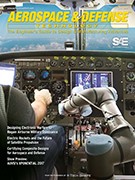Magazine

Aerospace & Defense Technology: April 2023
2023-04-06
Breathing Life into Artificial Intelligence and Next Generation Autonomous Aerospace Systems Robotic Rotational Molding Creates New Opportunities for Military and Aerospace Applications Rim-Driven Electric Aircraft Propulsion High-Speed Midwave Infrared Cameras Enable Military Test Range Tracking System What Today's Advances in Radar Technology Mean for Testing and Training Tackling Ruggedization Challenges for RF Communications in Software Defined Radios AUVSI XPONENTIAL 2023 The Blueprint for Autonomy Multi-Scale Structuring of the Polar Ionosphere Understanding a radically new sensing capability for polar ionospheric science introduced by observational evidence recently provided by the electronically steerable Resolute Bay Incoherent Scatter Radar (RISR). Stepped-Frequency Distributed Radar for Through-the-Wall Sensing A technical analysis of the effectiveness of distributed radar for through-the-wall sensing applications.







